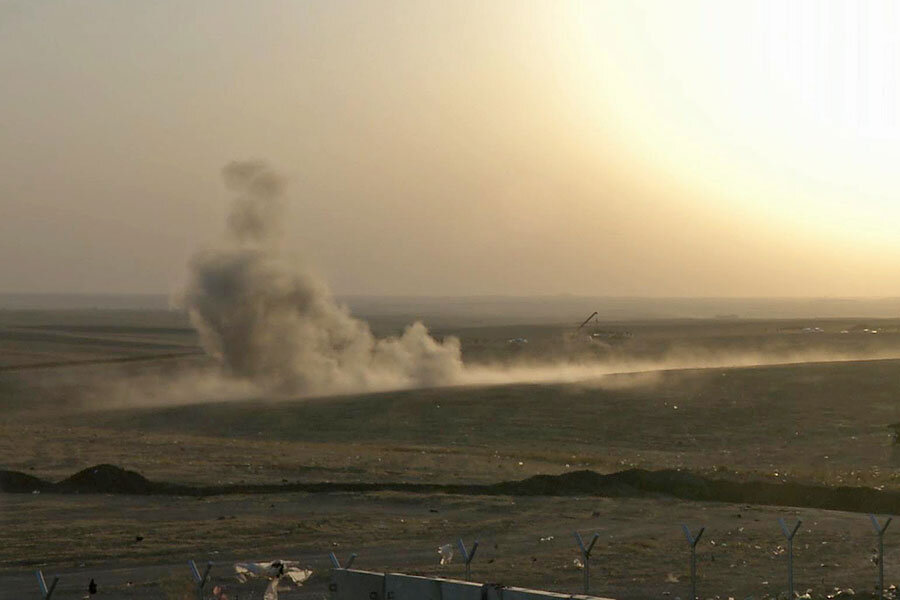US hits militants in northern Iraq again. How effective are air strikes?
Loading...
| Washington
Within hours of President Obama’s heads-up to the American public that he authorized the Pentagon to use military force in Iraq to counter the advance of Islamist militants there, the Pentagon did just that.
As Washington woke up Friday morning, it learned that two US F-18 fighter jets had started their campaign, dropping 500-pound laser-guided bombs near Erbil, the de facto Kurdish capital of northern Iraq. A second round of strikes was carried out later in the day, the Pentagon said.
Now, many are asking what the US can reasonably hope to accomplish with this bombing campaign. And more pointedly, could it become a slippery slope in which the US military moves beyond a targeted air campaign to actual US boots on the ground?
Obama sought to reassure war-weary Americans that this would not be the case. “I know that many of you are rightly concerned about any American military action in Iraq, even limited air strikes like these. I understand that,” he said. “As Commander-in-Chief, I will not allow the United States to be dragged into fighting another war in Iraq.”
Of course, no leader aspires to be “dragged into” war, which is often driven by gradual escalation. So the president sought to put a cap of sorts on US involvement. “Even as we support Iraqis as they take the fight to these terrorists, American combat troops will not be returning to the fight in Iraq,” he said. “However, we can and should support moderate forces who can bring stability to Iraq.”
A lot of damage 'in a hurry'
“Selective” airstrikes in northern Iraq “can do a lot of damage to ISIS forces in a hurry,” says Anthony Cordesman, a defense analyst at the Center for Strategic and International Studies, referring to the self-declared Islamic State (IS), formerly known as the Islamic State in Iraq and the Levant. “The US has been flying reconnaissance over Iraq for some time. They must have the ability by now to target ISIS forces quite well.”
In the first airstrikes of this campaign, the US military took out a “mobile artillery piece” near Erbil, the Pentagon press secretary, Rear Adm. John Kirby, said in a statement. IS was using this artillery to shell Kurdish forces that are defending Erbil, the statement explained. Erbil is also where US personnel are located. In the second round of strikes, a drone was used to attack a mortar position, and four F-18s hit a convoy outside Erbil.
The problem, some analysts point out, is that airstrikes tend to be most helpful against troops when they are massing. As it stands now, IS is “too big and too dispersed,” argues Christopher Harmer, senior Navy analyst at the Institute for the Study of War.
“They aren’t vulnerable to air strikes the way the Republican Guard was with their armored tanks and artillery tubes,” Mr. Harmer says. “Yes, ISIS has some of that – and we can hit it and should – but, fundamentally it’s a light infantry terrorist organization. You can’t beat those guys by dropping a couple of bombs here and there.”
For this reason, Obama’s comment about not sending American "combat troops" to "fight" in Iraq is key. It offers the president a bit of wiggle room, should he chose to take it – and some defense analysts say that the president may need to.
'Enablers'
While Obama might not officially authorize “combat troops” he could send in “enablers,” like tactical air controllers. “At a minimum, we need a lot more special operators to guide in fixed-wing strikes – they are much more effective if you have someone on the ground calling them in,” says Harmer, a retired Navy officer who served as Deputy Director of Future Operations for the US Navy’s Fifth Fleet from 2006 to 2009.
That’s because IS has now effectively blended in with the population in large Iraqi cities like Mosul. If US forces want to help tip the scales in a battle between IS and northern Iraqi’s Kurdish Peshmerga forces, US troops carrying out the air strikes need to be able differentiate friend from foe, Harmer says.
“If ISIS and the Peshmerga are involved in a fight, there is no way we can bring air power to bear without incurring significant friendly fire casualties,” he says. “We are very good when we have our own troops in contact, because we use forward air controllers to do that.”
But some argue that even if US air strikes will not route IS, they can provide important benefits. These include offering some hope for beleaguered civilians and aiding Peshmerga forces, who have been sending out pleas for more ammunition on Twitter.
It will also be a much-needed wake-up call for IS, notes retired Maj. Gen. Charles Dunlap, now executive director of Duke University’s Center on Law, Ethics, and National Security.
“[IS] may be good at beheading bound captives and threatening helpless civilians, but they have not yet undergone the kind of physical and psychological trauma that American airpower can impose upon them,” Dunlap says.
'Saving what lives we can'
Along with the announcement that Obama authorized air strikes came some less controversial news. The White House launched a humanitarian air drop, carried out by US military planes, “to help save thousands of Iraqi civilians who are trapped on a mountain without food or water and facing almost certain death,” the president said.
“True, airstrikes for these limited purposes may not alter the strategic situation in Iraq, but there is much to be said for saving what lives we can today as we continue to work the larger issues,” says Dunlap. “This is a potential humanitarian catastrophe, and if we can prevent or mitigate it with a manageable level of risk – which I think we can – then we ought to do it.”







